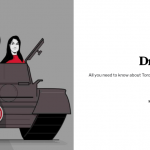Branded
How do I make my reputation as big as I can? Ryerson Review of Journalism writer Kristen Chamberlain looks into the wisdom of branding herself.
How do I make my reputation as big as I can? Ryerson Review of Journalism writer Kristen Chamberlain looks into the wisdom of branding herself.
It was November 2006 and I sat in my high school’s library as a university representative lectured a group of bored Grade 12 students about the importance of post-secondary education. I knew I was going to university. Both my parents had degrees, my brother was about to graduate, and to avoid that dreaded “black sheep” title I thought it best to do the same. But what would I study? I had failed math and barely squeaked by in science, ruling out the more logical left-brain careers. My only true passions were pot smoking, collage art and writing. The first two weren’t viable career options, so writing it was. In fall 2007 I was making the trek from the suburbs to my first Ryerson University reporting class, nervous and armed with the usual back-to-school necessities: pens, paper, high hopes and a copy of Charles Bukowski’s poem “So You Want to Be a Writer?” tucked into my notebook.
Later that first semester, when I struggled to meet deadlines or I found myself pulling caffeine-fuelled all-nighters, I’d pull the poem out and read it. It was my checklist: Did writing still roar out of me as Bukowski said it should in the poem? Did my words come unasked out of my heart and mind? I turned to that poem to remind myself why I wanted to be a journalist and to reassure myself that I still had “it” in me. In fact, those words guided me. If I could do right by Bukowski, I’d make it as a journalist — or so I thought.
Four years later, and four years older, I’m on the brink of earning my journalism degree. A little less naïve, I can say I’ve learned a lot since that first semester. I now realize that playing by a drunk, misogynistic poet’s rules may not cut it. It’s time to get down to business and think critically about my next moves. If I really want to make it in a changing industry with far more contenders than room in the ring, I need to find a way to stand out. It’s not enough to be Kristen Chamberlain — I need to be the Kristen Chamberlain. I need to…dare I say, brand myself? I still think of Coke and Adidas when I use that word. When did it morph from a noun to a verb? More importantly, how does a person become a brand and what does that entail? And is branding really what it takes to carve out a successful career as a journalist these days? I decided to try to find out.
The concept of personal branding was used by Tom Peters in 1997 in Fast Company magazine. Long before I knew what a nut graff or a lede was, long before I knew I wanted to be a journalist, Peters’s article about personal branding laid out the formula. It was systematic; it was cut throat; and it could be applied to any profession, any “human resource,” even a mechanic. Peters’s formula emphasized the power of networking, word-of-mouth marketing and, most importantly, realizing what makes you stand out from other people. Ultimately his advice was as simple as it was self-serving: brand yourself to set yourself apart from everyone else in your field; by doing so you will further your career.
So how does this branding concept apply to journalists? The need for journalists to brand themselves emerged with the evolution of the Internet, according to Allen Mutter, former city editor of the Chicago Sun-Times and author of the blog Reflections of a Newsosaur. “The Internet made it possible for people to acquire vast amounts of information and content from around the world, and it also made it possible for them to contribute their own content. It was not only a tool for getting information, but for giving it; and as a consequence, there’s been a complete inundation of sources of information,” says Mutter. The number of people who sit down to watch the network evening news has decreased in the U.S. by nearly 44 percent since 1980. Newspaper circulation has dropped precipitously in the new millennium, along with media outlet revenues, and many magazines have folded. Previously as a journalist, you would have affiliated yourself with a major media source, where the power of that business and its control on the market would have ensured that your writing was seen and your voice heard, says Mutter. Now the number of jobs for journalists in traditional institutions has decreased. “The audience and sources of information have fragmented,” he says, “so if you want to be heard amid all the clutter, then you need to stand up and get noticed. And that’s why it’s important to build an audience.” Or to put it another way, build your own brand.
With social media becoming the obvious tool for getting noticed amongst members of my generation, I figured it was the best place to start exploring the idea of building an audience and, I hoped, my brand. Myspace is dreary. My Facebook account is too private. What about Twitter? Could I promote the writing I have been doing for an online fashion publication to a larger audience on Twitter and gain a larger following? I’d never actually understood the appeal of Twitter but, on my way to school, I read an article about Breanna Hughes — a product manager by day and a Twitter celeb by web — in Metro, the daily commuter paper. The National Post had also just published an article featuring Hughes and her take on the power of social media. Clearly there was something to learn from her.
To continue reading, see Branded at the RRJ site.
[node:ad]



